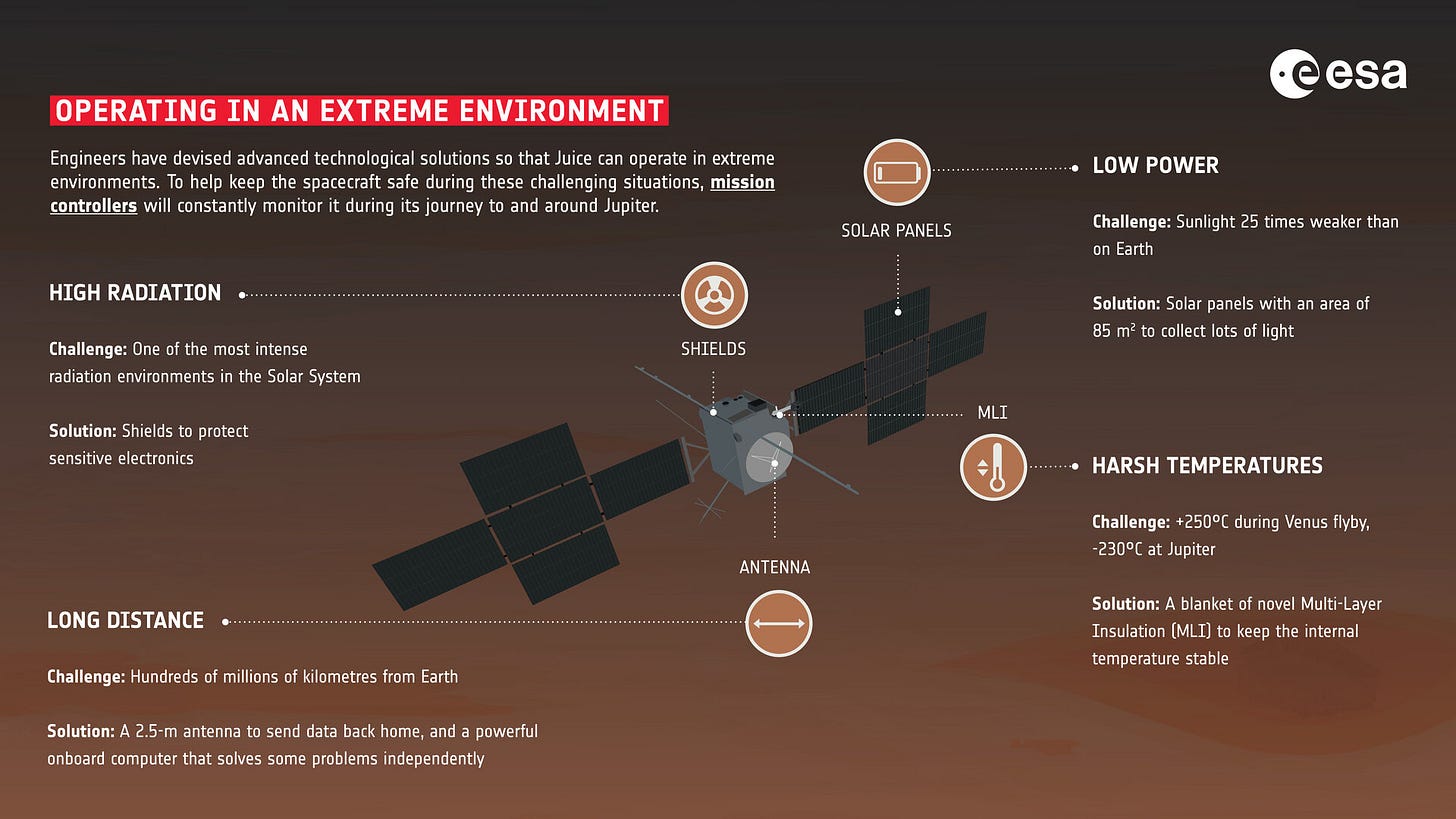#JUICELog: The Challenge of JUICE
What are the technical challenges of the JUICE mission, and how have the team tackled these?
As we have learned with Galileo and Juno, Jupiter does not give up its secrets easily. When it arrives in 2031, JUICE will become the third robotic spacecraft to orbit Jupiter, building on the lessons learned from these earlier explorers.
For example, we will keep our most sensitive components, hardware, and instruments locked away within a vault to protect them from the harsh radiation environment. We have also designed an orbit that will keep us away from the worst of Jupiter's radiation belts, which is why we only venture in as close as Europa twice, and why we'll only be able to view Io from a distance. We want a spacecraft that can do orbital reconnaissance for the long term, so that it can both provide the multi-year orbital tour of Jupiter, and survive long enough to become humankind's first orbiter of an icy moon, Ganymede. Juno got around this by spending most of its time in a high polar orbit, well clear of the damaging radiation… but for a satellite focussed on exploring moons in the equatorial plane, JUICE is afforded no such luxury.

The spacecraft will face other technical challenges - surviving the intense heat of a Venus flyby at 250 degrees Celsius, the intense cold (-230 degrees Celsius) within the Jupiter system, using 100 kg of thermal blankets known as MLI (multi-layer insulation) to maintain a stable temperature throughout the mission.
JUICE is a big and heavy spacecraft, measuring 16.8 x 27.1 x 13.7 m when it’s fully deployed in orbit, including the 10.6-m JMAG magnetometer boom that deploys during the early stages after launch. The two ‘wings’ of solar panels are the largest ever built for an planetary spacecraft, made up of ten 2.5 x 3.5 m panels (five on each side, 27m from edge to edge) with a total area of 85 m2 (and a total of 23 560 solar cells). Arrays of this size are needed to provide the 850 W of electrical power to the spacecraft, even at Jupiter’s great distance from the Sun, where solar energy per square metre is only 4% of what we have here at Earth.
JUICE weighs 2420 kg without fuel, without adding in the 3650 kg of propellant for all the navigation changes, Jupiter orbit insertion, and multiple planetary flybys. So a little over 6 tonnes at launch, JUICE will be the second heaviest planetary spacecraft launched after Phobos-2 (6.2 tonnes), and heavier than Cassini-Huygens (5.6 tonnes).
But I think the biggest challenge of JUICE has been more earth-bound. The global pandemic created great difficulties for the teams developing the hardware and components for this spacecraft. Instrumentation developed in labs, institutions, and industrial sites across the world had to be brought together by land, air, and sea at a time when international travel and collaborative in-person working was facing a challenge like no other. Cue some rather creative thinking and some astonishing perseverance, particularly from the teams at ESA, Airbus, and other industrial teams working to tight deadlines and tight budgets. When JUICE sits atop that Ariane 5 in April 2023, waiting to start the next phase of its journey, it'll be testament to the sustained effort of thousands here on Earth under challenges that no one foresaw when we were first dreaming of Europe's mission to Jupiter.
And Earthly concerns won’t stop there. JUICE has a long timespan from launch to the end of the science phase, during which time the scientists and engineers behind the mission will continue their lives - there’ll be retirements, aging, new commitments, and new talent arriving in the team. One thing’s for sure - when JUICE ends its mission in the 2030s, the team responsible for those final moments won’t be the same team that developed this mission in the mid 2000s!

